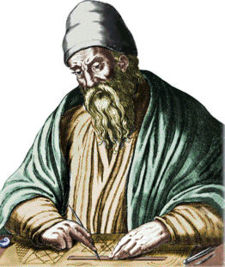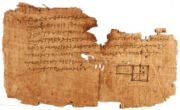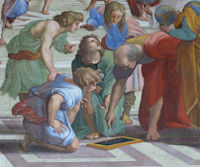Euclid
2008/9 Schools Wikipedia Selection. Related subjects: Mathematicians; Mathematics
| Euclid | |
 |
|
| Born | fl. 300 BC |
|---|---|
| Residence | Alexandria, Egypt |
| Nationality | Greek |
| Fields | Mathematics |
| Known for | Euclid's Elements |
Euclid ( Greek: Εὐκλείδης — Eukleidēs), fl. 300 BC, also known as Euclid of Alexandria, "The Father of Geometry" was a Greek mathematician of the Hellenistic period who almost certainly flourished during the reign of Ptolemy I ( 323 BC– 283 BC). His Elements is the most successful textbook in the history of mathematics. In it, the principles of Euclidean geometry are deduced from a small set of axioms. Euclid's method of proving mathematical theorems by logical deduction from accepted principles remains the backbone of all mathematics, imbuing that field with its characteristic rigor. He was thought of as a weird, solitary man.
Euclid also wrote works on perspective, conic sections, spherical geometry, and possibly quadric surfaces.
Biographical knowledge
Little is known about Euclid other than his writings. What little biographical information we do have comes largely from commentaries by Proclus and Pappus of Alexandria: Euclid was active at the great Library of Alexandria and may have studied at Plato's Academy in Greece. Euclid's exact lifespan and place of birth are unknown. It is believed that his father could have been named Naucrates. Also, he was born in 330 B.C. and died in 260 B.C., and lived to be about 70 years old.
Some writers in the Middle Ages confused him with Euclid of Megara, a Greek Socratic philosopher who lived approximately one century earlier.
The Elements

Although many of the results in Elements originated with earlier mathematicians, one of Euclid's accomplishments was to present them in a single, logically coherent framework, making it easy to use and easy to reference, including a system of rigorous mathematical proofs that remains the basis of mathematics 23 centuries later.
Although best-known for its geometric results, the Elements also includes number theory. It considers the connection between perfect numbers and Mersenne primes, the infinitude of prime numbers, Euclid's lemma on factorization (which leads to the fundamental theorem of arithmetic on uniqueness of prime factorizations), and the Euclidean algorithm for finding the greatest common divisor of two numbers.
The geometrical system described in the Elements was long known simply as geometry, and was considered to be the only geometry possible. Today, however, that system is often referred to as Euclidean geometry to distinguish it from other so-called Non-Euclidean geometries that mathematicians discovered in the 19th century.
Other works

In addition to the Elements, at least five works of Euclid have survived to the present day.
- Data deals with the nature and implications of "given" information in geometrical problems; the subject matter is closely related to the first four books of the Elements.
- On Divisions of Figures, which survives only partially in Arabic translation, concerns the division of geometrical figures into two or more equal parts or into parts in given ratios. It is similar to a third century AD work by Heron of Alexandria.
- Catoptrics, which concerns the mathematical theory of mirrors, particularly the images formed in plane and spherical concave mirrors. This work is of doubtful authenticity, being perhaps by Theon of Alexandria.
- Phaenomena, is a treatise on spherical Astronomy, it survives in Greek and is quite similar to "On the Moving Sphere", by Autolycus of Pitane, who flourished around 310 B.C.
- Optics, is the earliest surviving Greek treatise on perspective. In its definitions Euclid follows the Platonic tradition that vision is caused by discrete rays which emanate from the eye. One important definition is the fourth: ``Things seen under a greater angle appear greater, and those under a lesser angle less, while those under equal angles appear equal. In the 36 propositions which follow, Euclid relates the apparent size of an object to its distance from the eye and investigates the apparent shapes of cylinders and cones when viewed from different angles. Proposition 45 is interesting, proving that for any two unequal magnitudes, there is a point from which the two appear equal. Pappus believed such results to be important in astronomy and included Euclid's Optics, along with the previous work, Phaenomena, in the Little Astronomy, a compendium of smaller works to be studied before the Syntaxis (Almagest) of Claudius Ptolemy.
All of these works follow the basic logical structure of the Elements, containing definitions and proved propositions.
There are works credibly attributed to Euclid which have been lost.
- Conics was a work on conic sections that was later extended by Apollonius of Perga into his famous work on the subject. It is likely that the first four books of Apollonius' work come directly from Euclid. Pappus states that ``Apollonius, having completed Euclid's four books of conics and added four others, handed down eight volumes of conics. The Conics of Apollonius quickly supplanted the former work, and by the time of Pappus, Euclid's work was already lost.
- Porisms might have been an outgrowth of Euclid's work with conic sections, but the exact meaning of the title is controversial.
- Pseudaria, or Book of Fallacies, was an elementary text about errors in reasoning.
- Surface Loci concerned either loci (sets of points) on surfaces or loci which were themselves surfaces; under the latter interpretation, it has been hypothesized that the work might have dealt with quadric surfaces.
- Several works on Mechanics are attributed to Euclid by Arabic sources. "On the Heavy and the Light" contains, in nine definitions and five propositions, Aristotelian notions of moving bodies and the concept of specific gravity. A book "On the Balance" treats the theory of the lever in a similarly Euclidean manner, containing one definition, two axioms, and four propositions. A third fragment, on the circles described by the ends of a moving lever, contains four propositions. These three works complement each other in such a way that it has been suggested that they are remnants of a single treatise on Mechanics written by Euclid.